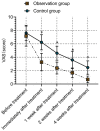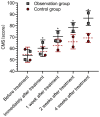Study of the therapeutic effects of betamethasone injection combined with musculoskeletal ultrasonography compared with radial shock wave therapy in the treatment of tenosynovitis of the long head of the biceps brachii
- PMID: 33841696
- PMCID: PMC8014383
Study of the therapeutic effects of betamethasone injection combined with musculoskeletal ultrasonography compared with radial shock wave therapy in the treatment of tenosynovitis of the long head of the biceps brachii
Abstract
Objective: To compare the therapeutic effects of compound betamethasone injection (CBI) combined with musculoskeletal ultrasonography (MSUS) and radial shock wave therapy (RSWT) in the treatment of tenosynovitis of the long head of the biceps brachii tendon (TLHBBT).
Methods: A total of 93 patients with TLHBBT admitted to our hospital were selected and randomly divided into an observation group (n=48) and a control group (n=45). The control group received RSWT, while the observation group received CBI combined with MSUS. The therapeutic effects were compared between the two groups.
Results: The visual analog scale scores for the affected sites in the observation group were lower than those in the control group immediately after treatment and at 1, 2 and 4 weeks after treatment, while the constant-Murley scale scores for the active range of motion for shoulder forward flexion and shoulder joint function in the observation group were higher than those in the control group (P < 0.05). After treatment, the positive rate in Yergason's test in the observation group (2.08%) was lower than that in the control group (15.56%), while the negative rate in the observation group (97.92%) was higher than that in the control group (84.44%) (P < 0.05). The overall response rate (ORR) in the observation group (93.75%) was higher than that in the control group (80.00%) (P < 0.05).
Conclusion: CBI combined with MSUS, is superior to RSWT in treating TLHBBT, and it can remarkably reduce pain, increase joint range of motion, and improve joint function.
Keywords: Tenosynovitis of long head of biceps brachii; compound betamethasone injection; musculoskeletal ultrasonography; radial shock wave; treatment.
AJTR Copyright © 2021.
Conflict of interest statement
None.
Figures




References
-
- Pfeiffer M, Eibl P, Schuh A. Clinical examination of the shoulder joint - part 2. MMW Fortschr Med. 2019;161:57–61. - PubMed
-
- Wilson RD, Chae J. Hemiplegic shoulder pain. Phys Med Rehabil Clin N Am. 2015;26:641–655. - PubMed
-
- De la Rosa-Morillo F, Galloza-Otero JC, Micheo W. Shoulder pain rehabilitation in young athletes. Rehabilitacion (Madr) 2019;53:85–92. - PubMed
-
- Saito H, Harrold ME, Cavalheri V, McKenna L. Scapular focused interventions to improve shoulder pain and function in adults with subacromial pain: a systematic review and meta-analysis. Physiother Theory Pract. 2018;34:653–670. - PubMed
-
- Geannette C, Williams D, Berkowitz J, Miller TT. Ultrasound-guided biceps tendon sheath injection: spectrum of preprocedure appearances. J Ultrasound Med. 2019;38:3267–3271. - PubMed
LinkOut - more resources
Full Text Sources
